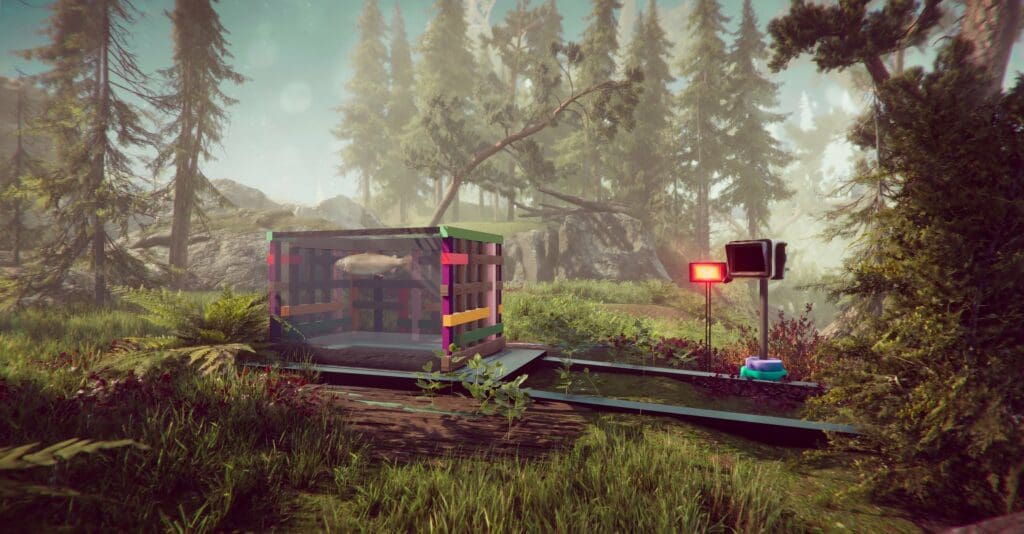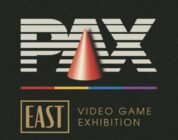We may be entering the age of spaceflights, artificial intelligence, and augmenting the human body with cybernetic parts, but we cannot escape a fundamental rule. Humans are part of nature. Every fiber, atom, and DNA strand of our being is tied to this planet and the natural world. However, as a dominant and evolved species that has chartered most of the planet, we have had an impact, both good and alarmingly bad. Every sip of coffee, every mile we drive, and every time we take out the trash, we often forget what is happening in the natural world, and how it affects others.
There aren’t many video games regarding the environment, but every so often, you find one that captures and intrigues you and that game happens to be The Forest Cathedral from Whitethorn Digital. What starts off as a science fiction mystery in the woods soon grows into something more puzzling, and engrossing.
The Forest Cathedral struck me when it was first teased many months ago. The trailer introduced a unique retro-future-styled walk through nature, but the poster was what grabbed me with its surreal and strange framing. A woman stands in the center, with her skeleton partially exposed. Two arms hold an eagle in each, while another hand makes a religious gesture, flanked by two skulls. The poster already hinted at the kind of surreal adventure players are likely to embark on, but then I had a chance to play the demo at PAX East and the mystery only leaves me wanting more.
The Forest Cathedral combines several different elements together, both in regards to gameplay and visuals. At the outset, players begin in a fully 3D environment, which appears to be a small outpost, deep within a forest in the Northeast. Players play as Rachel Carson, a scientist observing wildlife in the woods. The first objective involved getting in touch with the Professor. It’s Friday, which the protagonist refers to as Fishy Friday. The goal of the demo is to capture a fish and find out what is happening to the fish. Additionally, it is discovered that the mosquitoes seem to be attracted to some kind of substance. Rachel’s alarming state suggests the mosquitoes are absorbing a poison of some type that is affecting the entire ecosystem.
As the communication continued, Rachel was reflected in the video calls as a 2D pixelated character, as a character one would likely see in a 2D platformer, with the professor being portrayed similarly on the other screen. Shortly after the call concludes, a special scanner is retrieved. The scanner, when toggled, is a portable device that takes up the left side of the screen. The scanner portrays the world as black and red, with some white, with white illuminating an important objective. The scanner’s retro appearance, and the exploration of the world, all give off a retro-futuristic 80s vibe as if The Forest Cathedral is tapping into a Spielbergian world. Eventually, the scanner leads me to an interface at the river, to a valve, referred to by Rachel as Mr. Valve. The demo then introduces another fascinating mechanic for The Forest Cathedral.
To solve the puzzles and obstacles of The Forest Cathedral, players use the scanner, which then turns into a game within a game. The scanner manifests the puzzle into a 2D action platformer, featuring what the protagonist calls Little Man. The scanner portrays a level to navigate through, which is a level clearly inspired by Mario Bros. As Little Man, players jump across gaps, wall jump to overcome challenges, and even swing a sword to fight enemies. It felt as if I was playing a forgotten title from Nintendo’s ill-fated Virtual Boy. By winning the level, the puzzle in the real world is solved, and the demo continues.
The demo continues these examples of gameplay until the end when it comes time to capture a Salmon. The Forest Cathedral then displays its most challenging level within the scanner, complete with challenging platforming. Dying in these levels isn’t the end of the world, however, and following the Super Meatboy playbook. players re-materialize almost instantly. The level becomes a puzzle to retrieve a fish, complete with pipes, traps, an underwater section, and a pixelated fish. After a time of figuring out the platforming, and dying quite a lot, I was able to retrieve a large fish. The demo concludes by analyzing the fish, discovering that the fish has been eating the same dangerous mosquito that was warned at the beginning of the demo. Retrieving the fish, Rachel makes an observation, only for the fish to be swept up by a bird of prey. With that, the demo ends.
Fascinated and thrilled with the demo, I manage to speak to developer Brian Wilson, the architect of The Forest Cathedral. To my surprise, it turns out, that The Forest Cathedral is about an important piece of ecological history and that is the fight against DDT. Players play as Rachel Carson, who, in fact, is a real person. In the 1950s, Rachel Carson, a writer, and Marine biologist observed the natural world, writing books pertaining to the ocean and its importance to the planet. Later in the 1950s, she turned her attention to conservation and began observing the harmful impacts of pesticides. At the time, it was revealed that pesticides, including DDTs, were responsible for the thinning of eggshells for various birds of prey, including the peregrine falcon, which was nearly driven to extinction. Additionally, marine creatures, such as crayfish, were affected, and it was later revealed that the chemical affected the human body, especially pregnancies.
In 1962, two years before her death, Rachel published Silent Spring, which details the carnage of DDT. Her book broke barriers and blazed a trail that lead to the formation of grassroots movements, which then in turn led to the creation of the Environmental Protection Agency, or what is commonly known today as the EPA. The Forest Cathedral acts as a dramatic and psychological retelling of the scourge of DDT, and this milestone moment of action. Seeing The Forest Cathedral become a vehicle for this important moment in environmental history was astounding and profound, using the aspects of science fiction to lend an important experience to players.
This kind of storytelling isn’t easy in today’s gaming world. Most gamers will roll their eyes and throw their hands at the mere mention of values or themes like environmental protection or a woman making history. I can understand if a game becomes “ham-fisted” and doesn’t allow for the player to think or figure things out on their own. Based on my time with The Forest Cathedral, the game is shaping not to be pushy, or preachy, but instead a message and experience to be felt and understood. Video games can teach lessons and moments in history. Video game scan put the player into the shoes of persons and experience stat no movie or show could possibly demonstrate. It is that level of interactivity and participation that can give players a true glimpse into a viewpoint or message. I have felt that, personally with many games, and while it was a demo. It’s something I felt with The Forest Cathedral. It is further bolstered by the fact that I had never heard of Rachel Carson, and the issue of DDTs was something taught to me briefly in grammar school, but not honed in later on. If a game can introduce me to a part of history I knew little about, that is a significant victory in my book. For that, The Forest Cathedral was awarded Writer’s Choice by Marooner’s Rock at PAX East, and looking back on the experience, it more than earned it.
The Forest Cathedral may not be for everyone but I would encourage everyone to keep it on their radar. It is shaping to be a surreal and fascinating sci-fi adventure, based on a real pioneer for environmental and human rights, and for that, I must encourage all to play it. Its unique take on gameplay, exploration, and scientific adventure, all wrapped into an 8-0s Spielbergian mystery has been curious as to the game’s launch, and finally uncovering the mystery within.
The Forest Cathedral launches late Summer of 2022 for Steam, with at least one unspecified console confirmed.







